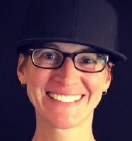Do you know how many people in the world are classified as DeafBlind? What is the actual medical definition of the word “DeafBlind”? Read on to find out and to learn about how we’re helping to bring the telecommunications technology to the DeafBlind community.
“DeafBlind” is a spectrum of individuals who experience both hearing and vision loss. This spectrum includes individuals who are hard of hearing and have low vision, deaf and have low vision, hard of hearing and blind, deaf, and blind. Causes vary. According to the World Health Organization, an estimated of 2.2 billion people are within the blind spectrum (ranging from wearing corrective lens, to being legally blind, to being completely blind), and 1.5 billion people who are within the deaf spectrum (ranging from experiencing some hearing loss, to being mild to profoundly deaf).
In addition to this, the World Federation of the DeafBlind (WFDB) estimates that approximately 2% of the world’s population is both deaf and blind. This DeafBlind community is diverse and amazing in its many forms of communication. Some use an audio-based modality, while others use both audio- and visual-based modalities. Still others prefer tactile-based modalities. Among these, some prefer tactile modalities alone, while others rely on audio inputs from their devices.
While diverse in communication, the community and its needs are often misunderstood, and it frequently lacks access to education, training, employment, and resources. Furthermore, many are unaware of how best to use technology tools that can make communication easier. For example, the common task of sending a text, email, or connecting on the phone can be challenging for DeafBlind people, despite best practices that, if understood, could greatly increase the benefit of these tools to the community.
Inspired by its decades-long commitment to accessible communication, T-Mobile Accessibility collaborated with State Telecommunications Relay partners to showcase technology through “Taste of Technology” (TOT) events.
TOT events encourage hands-on experience for the community with communication products and services, and discuss these tools, as well as many other accessible communication tools such as T-Mobile IP Relay and Conference Captioning.
T-Mobile IP Relay enables people who are Deaf, Hard of Hearing, DeafBlind, or who have a Speech Disability to make and receive phone calls using text instead of audio. This federally funded service is confidential, requires only an internet-connected device and a web browser or a mobile app.
T-Mobile also offers captioning for online meetings and conference calls (sometimes called Relay Conference Captioning or “RCC”). This communication tool combines real-time captioning and voice relay to make these calls and virtual meetings accessible.
In sum, TOT raises the awareness of these tools by encouraging a direct connection to others in the community and to technology that can make a meaningful impact on how quickly and easily communication occurs.
For more information about T-Mobile IP Relay or its captioning services for people who are DeafBlind– please email Keith Clark at Deafblind@t-mobile.com. Sarah and Keith can discuss the options, benefits, and schedule presentations at no cost to your organization, business, or schools.
Resources:
- DeafBlindness in the World: https://wfdb.eu/deafblindness-in-the-world
- I Can Connect (ICC): https://www.icanconnect.org/
- Impact of DeafBlindness on Learning: https://www.nationaldb.org/info-center/educational-practices/impact-on-learning.
- Library Services for the Deaf and Hard of Hearing: https://tndeaflibrary.nashville.gov/event/tennessee-taste-of-technology-10-21-2023
- National Center on DeafBlindness: https://www.nationaldb.org/
- New Jersey Taste of Technology: https://njrelay.com/wp-content/uploads/2023/03/ToT-DB-NJ-Flyer-FINAL-v3.pdf
- North Carolina Taste of Technology: https://relaync.com/wp-content/uploads/2022/11/Taste-of-Technology-2023.pdf
- Relay Colorado hosts Safari Day: https://www.relaycolorado.com/zoo/
- Relay Conference Captioning (RCC): Teleconference Captioning Service | T-Mobile Accessibility (tmobileaccess.com)
- T-Mobile IP Relay app: T-Mobile IP Relay Mobile App | T-Mobile Accessibility (tmobileaccess.com)
- Tennessee Taste of Technology: https://todb.org/Article/17
- Traditional Relay Service (TRS): https://www.tmobileaccess.com/services/trs


